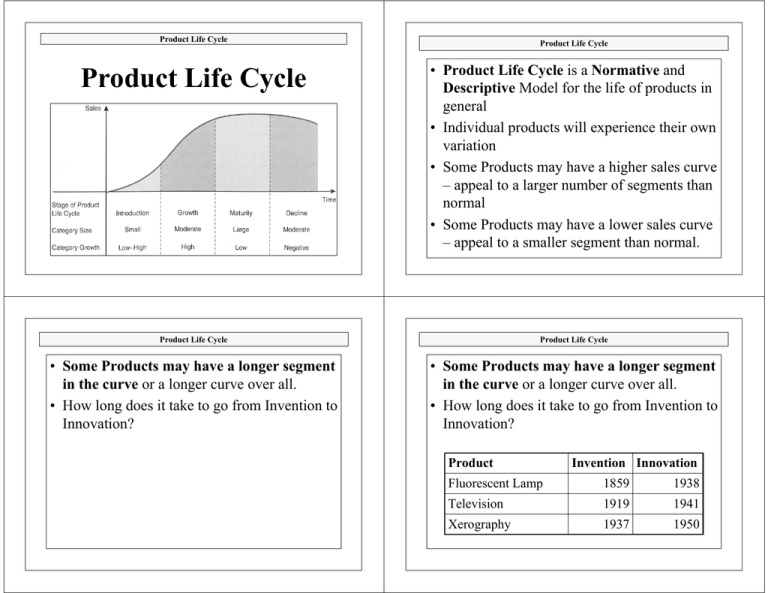Product Life Cycle
advertisement

Product Life Cycle Product Life Cycle Product Life Cycle • Product Life Cycle is a Normative and Descriptive Model for the life of products in general • Individual products will experience their own variation • Some Products may have a higher sales curve – appeal to a larger number of segments than normal • Some Products may have a lower sales curve – appeal to a smaller segment than normal. Product Life Cycle Product Life Cycle • Some Products may have a longer segment in the curve or a longer curve over all. • How long does it take to go from Invention to Innovation? • Some Products may have a longer segment in the curve or a longer curve over all. • How long does it take to go from Invention to Innovation? Product Invention Innovation Fluorescent Lamp 1859 1938 Television 1919 1941 Xerography 1937 1950 Product Life Cycle Product Life Cycle • Some Products may have a longer segment in the curve or a longer curve over all. • The Safety Razor was invented by Gillette in 1895, the Gillette Safety Razor Company introduced the product in 1904. • Where is it now in its Product Life Cycle? • Some Products may have a shorter segment in the curve or a shorter curve over all. • Freon Refrigerants were invented in 1930 and introduced in a product – Refrigerator – in 1931. Product Life Cycle Product Life Cycle • Some Products may have a shorter segment in the curve or a shorter curve over all. • Anyone know about Pokemon prior to 1998? • Where is it now in its Product Life Cycle? • “On the East Coast, retailers are discounting the newest set of collectable Pokemon trading cards in an attempt to jumpstart sales.” (Sacramento Bee, June 3, 2000, p. I1) • A Short Product Life Cycle is one of the hallmarks of a FAD. • Product Life Cycle is a Normative and Descriptive Model for the life of products in general • The PLC’s importance to marketing decision makers is to help identify appropriate strategies and tactics for presenting a product. • Each stage represents a different set of uncontrollable variables to consider in the development of product and market strategies. Product Life Cycle • • • • • In the Introductory Stage The Product is Unknown The Price is generally high The Placement is selective The Promotion is generally personalized and informative Product Life Cycle • • • • • Product Life Cycle • • • • • In the Maturity Stage The Product is competing with alternatives The Price reaches it’s lowest point The Placement is intense The Promotion is focused on the competition and repeat purchasing In the Growth Stage The Product’s capabilities are being recognized The Price will begin to decline, with volume The Placement becomes more wide spread The Promotion is focused on the product’s need satisfying properties Product Life Cycle • • • • • In the Decline Stage The Product faces reduced competition The Price rises as volume declines The Placement tends back to being selective The Promotion is focused on reminding Product Life Cycle Product Life Cycle Diffusion of Innovations • The Receivers change from stage to stage and, therefore • The Decoding changes from stage to stage • The Receiver changes are modeled as the Adoption Curve or The Diffusion of Innovations (Winer, p. 420-1). Source: Rogers, Everett M, Diffusion of Innovations, 4th ed. (New York: Free Press, 1995. Product Life Cycle • The Adoption Curve, like the PLC, is a Normative and Descriptive Model to aid decision making • Some Receivers are Innovators, some are Laggards, and some are in between. • Where your product is in the PLC relates to which group of receivers you should be addressing. • Each of the adopter categories has its own characteristics Product Life Cycle • Innovators are there at the beginning (2.5%) • Innovators are not a true receiver • They will create their own solution to a felt need and, in many situations, spur the sender into developing a commercial product • PC as an example – the Innovators were the builders of Heath Kit and North Star computers or they bought used main frames and installed them in their homes. Product Life Cycle • • • • Early Adopters are the first true receivers (13.5%) They tend to be the risk-takers and trend setters. They tend to be younger They utilize a great number of information sources that tend to be in closer contact with the origin of new ideas – personal selling • They tend to be viewed as information sources by their network of peers. • They are the Receivers during the Introductory and early Growth stages of the PLC Product Life Cycle • Late Majority are the last true receivers (34%) • They are the Receivers of the Maturity Stage when the product is firmly established • They are skeptical and risk aversive • They utilize advertising and mass media as major information sources Product Life Cycle • Early Majority are the profitable receivers (34%) • They are the Receivers of the Growth and early part of the Maturity Stages (the part of the PLC that tends to generate the highest profitability) • They are the first to utilize advertising as a major information source • They also follow the lead of the Early Adopters Product Life Cycle • Laggards are the last receivers (16%) • They are the Receivers of the later Maturity Stage and the Decline Stage • They are tradition bound and very slow to change • They tend to be immune advertising, waiting until the product has become tradition itself



